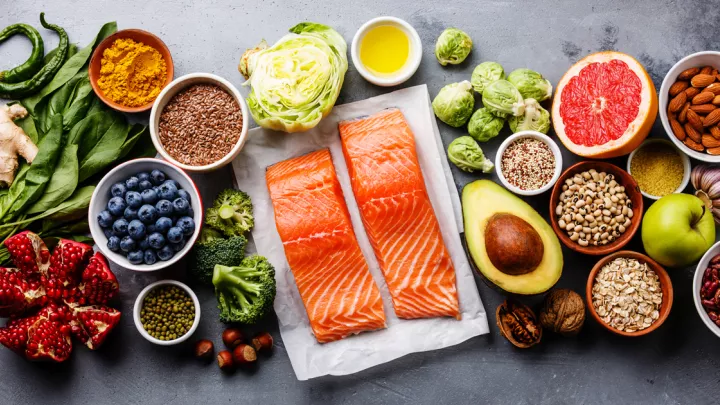Prevent brain aging and decrease Alzheimer’s risk with the MIND diet

Did you know that eating some foods – and avoiding others – can affect how quickly your brain ages? It's called the MIND diet, and it can slow your brain aging by up to 7.5 years.
Here, nutrition therapist Jenna Wuebker, MS, RD, LMNT, explains the MIND diet and how to follow it.

What is the MIND diet?
MIND stands for Mediterranean-DASH Intervention for Neurodegenerative Delay. Designed by brain researchers, the MIND diet helps your brain function. The MIND diet combines foods from the Mediterranean and DASH diets.
"The Mediterranean diet is based off the lifestyle and eating patterns of those that live in the Mediterranean area of the world," explains Wuebker. "The DASH diet was originally established to lower blood pressure."
The MIND diet lists certain foods to include and other foods to limit each week. "The MIND diet puts a lot of emphasis on plant-based foods and naturally occurring foods," says Wuebker. "It also limits intakes of animal fats and high saturated fat foods."
10 foods to include on the MIND diet
Here are 10 foods to eat more of for better overall health. Along with supporting your brain health, the MIND diet can reduce inflammation, improve heart health and help you lose weight.
Green leafy vegetables
- How much: 6+ servings a week
- Serving size: 1 cup raw or ½ cup cooked
- Examples: Spinach, kale, collards, mustard greens and arugula
Other vegetables
- How much: 1+ serving each day
- Serving size: ½ cup
- Examples: Asparagus, broccoli, Brussels sprouts, carrots, cauliflower, green beans, mushrooms, onions, snow peas, squash, bell peppers, sweet potatoes and tomatoes
Nuts
- How much: 5+ servings a week
- Serving size: 1 ounce
- Examples: Almonds, cashews, hazelnuts, Brazil nuts, macadamia nuts, peanuts, pecan halves and walnut halves
Berries
- How much: 2+ servings a week
- Serving size: ½ cup
- Examples: Blackberries, blueberries, raspberries and strawberries
Beans and legumes
- How much: 3+ servings a week
- Serving size: ½ cup
- Examples: Black beans, pinto beans, cannellini beans, garbanzo beans, kidney beans, red beans, white beans and edamame
Whole grains
- How much: 3+ servings a day
- Serving size: ½ cup or 1 slice
- Examples: Whole grain bread, brown rice, wild rice, whole grain pasta, quinoa, barley, bulgur, farro, oats and whole grain cereal
Fish
- How much: 1+ serving a week
- Serving size: 3 to 5 ounces
- Examples: Salmon, tilapia, cod, halibut, mahi-mahi, canned tuna
Poultry
- How much: 2+ servings a week
- Serving size: 3 to 5 ounces
- Examples: Skinless chicken breast and skinless turkey breast
Extra virgin olive oil
- How much: 2 servings a day
- Serving size: 1 tablespoon
- Examples: Extra virgin olive oil, can be used in salad dressings, sauteing, dip for bread or roasting vegetables
Red wine
- How much: 1 serving a day
- Serving size: 5 ounces
- Examples: Red wine, red grapes or dark purple grape juice
These food groups contain specific nutrients:
- Green leafy vegetables provide folate, vitamin E, vitamin K, carotenoids and flavonoids
- Other vegetables provide fiber, folate, potassium, vitamin A and vitamin C
- Nuts provide fiber, magnesium and omega fatty acids
- Berries provide fiber, vitamin C and antioxidants
- Beans and legumes provide protein, fiber, folate, iron and phosphorus
- Whole grains provide iron, B vitamins, folate, fiber, selenium, potassium and magnesium
- Fish provide protein, omega fatty acids, iron and vitamin D
- Poultry provide protein and vitamin B12
- Extra virgin olive oil provides omega fatty acids and vitamin E
- Red wine contains resveratrol
"Eat some foods every day, like vegetables, while other foods just a few times a week," says Wuebker. "The goal is to make these foods the basis of your meals and snacks."
"The MIND diet is rich in antioxidants, which can reduce oxidative stress, providing many benefits to our body and brain," says Wuebker. Berries have the highest concentration of antioxidants among any fruit.
5 foods to limit on the MIND diet
Then there are five foods that the MIND diet suggests to limit.
"The key word here is limit," says Wuebker. "That doesn't mean you can't have these foods. It's more to be aware of how much you're having and how often."
Red meat and processed meat
- How much: Less than 4 servings a week
- Serving size: 3 to 5 ounces
- Examples: Beef, lamb, pork, ham, burgers, hot dogs, sausage, bacon, roast beef and salami
Butter and stick margarine
- How much: Less than 1 serving a day
- Serving size: 1 pat or 1 teaspoon
- Examples: Butter, stick margarine
Full-fat cheese
- How much: Less than 1 serving a week
- Serving size: 1 ounce or 1 slice of cheese or ¼ cup shredded cheese
- Examples: Cheddar cheese, colby cheese, Swiss cheese, mozzarella cheese
Pastries and sweets
- How much: Less than 5 treats a week
- Serving size: 1 treat
- Examples: Cake, sweet rolls, donut, cookies, brownies, pie, candy, ice cream and pudding
Fried foods and fast foods
- How much: Less than 1 time a week
- Serving size: 1 meal
- Examples: Fast food, fast casual restaurants, chicken strips, onion rings, french fries, mozzarella sticks, potato chips
How to reduce your Alzheimer's risk
The biggest risk factor for Alzheimer's is age. After age 65, the risk of Alzheimer's doubles every five years.
But about half of Alzheimer's disease risk is due to manageable risk factors – things you can control.
Lifestyle changes that reduce your risk:
- Diet
- Mental activity
- Physical activity
- Good emotional health and social connections
- Avoiding Type 2 diabetes
- Getting enough regular sleep
- Limiting alcohol
- Not smoking






